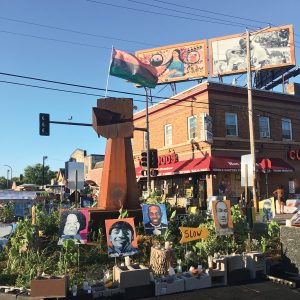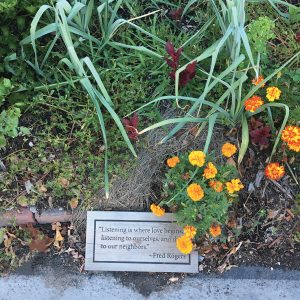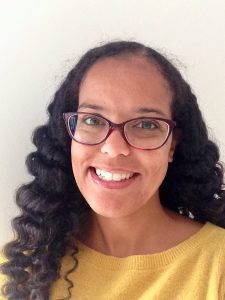Shekela Wanyama, Conductor, USA
The United States is in the midst of what some media outlets have called a “racial reckoning.” The Black Lives Matter movement, initiated in 2013, has raised national and international awareness of the murders of Black people at the hands of police. Unprecedented numbers of people arriving at the southern border of the United States are testing the under-resourced immigration system, and highlighting the challenges faced by immigrants once they enter the country. The presidency of Donald Trump unleashed a rise in hate speech and violence against Indigenous, Asian, Latinx, African, African American, Muslim, and Jewish people. States are passing voting rights legislation that will have a massive impact on the ability of Black/African American, Indigenous, and Latinx communities to vote in elections.
In the midst of this all, the murder of George Perry Floyd, Jr. by four police officers in May 2020 set off an uprising that began in the streets of Minneapolis, Minnesota, and spread around the world. Here in Minneapolis, protests are continuing daily and in numerous ways. At George Floyd Square, neighbors are maintaining the space and memorial to George Floyd as a site of radical community inclusion. One can find mental and physical health support, weekly cookouts, a library, clothing exchange, a community garden in the summer and a fire to stay warm in winter — all provided by volunteers and free to anyone. During one of my visits to the Square, a leader shouts out, “Show them what community looks like!” A group of supporters answers: “THIS is what community looks like!” I often wonder what our global choral art would look like if we practiced such radical hospitality.
Many choral conductors and educators in the United States are questioning our teaching and conducting practices and learning our role in systems of oppression in this country and abroad. We are learning more about the U.S.’s devastating legacy and continuing practices of racial and ethnic genocide, violence, and discrimination. We are gaining a deeper understanding of how our field can be more welcoming to all people. This article will attempt to provide a brief overview of these efforts.
Equal access to education in the United States is a centuries-long struggle. In the late 1990s and early 2000s, educators often practiced the idea of multiculturalism. Among music educators, this concept aimed to broaden curriculum to include genres and musicians from around the world. Community and religious choirs followed the lead of music educators and began programming music beyond the Western classical music canon. As a consequence, music arrangers and publishers flooded the market with so-called “multicultural” music often arranged by composers and conductors who usually had little or no contact with musicians from the cultures that inspired the music. This resulted in the proliferation of cultural appropriation in choral music, whereby musical elements were taken out of cultural context and misused. The profits from the sale of these often popular arrangements went primarily to the publishers and arrangers, almost never to the original artist or community that gave birth to the music.
More recent efforts seek to remedy this flawed process. Many educators, conductors, and choral ensembles are seeking out experts in non-Western classical music genres to work directly with students and singers, or studying with experts that will allow them to share music from a variety of cultures with more respect and a deeper understanding of the music and the performers and composers who make the music. The decline of the multicultural era has coincided with recent efforts toward diversity, equity, accessibility, and inclusion.

The terms diversity, equity, accessibility, and inclusion (DEAI) rest on the belief that to create a truly equal society, all people must have equal opportunity and access to resources. These resources include education, healthcare, safe shelter, nourishing food, and cultural connection. Although race is the focus of this article, DEAI work encompasses efforts to support individuals from all racial and ethnic backgrounds, physical and intellectual abilities, sexual orientations, genders, economic status, and religions. The work is complex, time-consuming, never-ending, and necessary as the United States becomes an increasingly diverse country. DEAI work is not without significant opposition, however many school, religious, and community leaders — including choirs and their conductors — are undertaking this work.
True DEAI work must be done by the individual and organization at the same time. Systems of oppression are built and maintained by individual attitudes and perspectives. For example, DEAI work related to race includes not only learning about the peculiar history of race in the United States, but also identifying one’s own personal history and beliefs, and then working to change them. Organizational planning and restructuring around DEAI can prove fertile ground for renewed vitality, more impactful engagement, and a broader reach among audiences and musicians. This intense and multi-year process requires the willing participation of all organization members, a high degree of trust in leadership and one another, and a commitment to stay the course when times are challenging.
Fortunately, organizations and individuals seeking to do this work are not alone. Available resources include books, discussion groups, podcasts, and workshops. A small selection of resources for DEAI work in the U.S. context is at the end of this article.
Everyone’s journey through DEAI work will be unique to them. My own work remains complex, challenging, and enriching. I am a biracial Black woman with one white and one Black parent. One of my parents is also an immigrant. These facts alone determine many things about my life and position within the U.S. socio-racial-economic hierarchies. In many ways, I am faced with challenges that most of my colleagues in our largely-white profession aren’t aware of now, or weren’t before 2020. Likewise, facets of my identity mean I possess a degree of privilege that has and continues to give me advantages in society and in our profession. When I can name my challenges and privileges, and put them into a socio-historical context, I can more clearly see how I can contribute to positive change in my spheres of influence, including how I can better serve my singers and the choral profession at large.
Undertaking DEAI work is more than professional development. It changes the way I interact with everyone I meet. I have learned to speak more openly with my students about resources available to them if they are experiencing social, emotional, physical, or financial difficulty. I am learning to be a better listener, both in rehearsal and in everyday life. I am developing the stamina to discuss and tackle difficult topics and problems, improving my communication skills, and — perhaps most importantly — experiencing more empathy and patience as I interact with colleagues, students, and neighbors. DEAI work teaches one to see the worst parts of humanity, and then to build a life that reflects the best in humanity.
The United States and the world need energetic, engaged, dedicated, caring, informed, and courageous people now more than ever. As choral practitioners, we are well-versed in building and sustaining communities. DEAI work, whether you are in the U.S. or in another country, will enable our profession to continue flourishing for generations to come.

Selected Resources for DEAI in the U.S. Context
Books
- Alexander, Michelle. The New Jim Crow: Mass Incarceration in the Age of Color-Blindness. New Press, Anniversary Edition, 2020.
- Bartholome, Sarah J. World Music Pedagogy, Volume V: Choral Music Education. Routledge, 2019.
- Coates, Ta-Nehisi. Between the World and Me. One World, 2015.
- DiAngelo, Robin. White Fragility: Why It’s so Hard for White People to Talk About Racism.Beacon Press, 2020.
- hooks, bell. Ain’t I A Woman: Black Women and Feminism. 2nd ed. Routledge, 2014.
- Howard, Karen. First Steps in Global Music. GIA Publications, 2020.
- Johnson Reagon, Bernice. If You Don’t Go, Don’t Hinder Me: The African American Sacred Song Tradition. University of Nebraska Press, 2001.
- Kendi, Ibram X. How to Be Anti-Racist. One World, 2019.
- Menakem, Resmaa. My Grandmother’s Hands. Central Recovery Press, 2017.
- Muhammad, Ghouldy. Cultivating Genius: An Equity Framework for Culturally and Historically Responsive Literacy. Scholastic Teaching Resources, 2020.
- Oluo, Ijeoma. So You Want to Talk About Race. Seal Press, 2019.
- Paris, Django and H. Samy Alim, eds. Culturally Sustaining Pedagogies: Teaching and Learning for Justice in a Changing World. Teachers College Press, 2017.
- Schippers, Huib. Facing the Music: Shaping Music Education from a Global Perspective. Oxford U. Press, 2009.
- Waziyatawin, PhD. What Does Justice Look Like? The Struggle for Liberation in Dakota Homeland. Living Justice Press, 2008.
Podcasts
- All My Relations with Matika Wilbur, Desi Small-Rodriguez, and Adrienne Keene
- Bearing Witness with Anthony and Georgia
- The Choral Commons with Emilie Amrein and André de Quadros
- Classically Black Podcast with Dalanie and Katie
- Into America with Trymaine Lee
- Our Body Politic with Farai Chideya
- Undistracted with Brittany Packnett Cunningham
Online Resources for Organizations
- Chorus America https://chorusamerica.org
- Courageous Conversation https://courageousconversation.com/
- Intercultural Development Inventory https://idiinventory.com/
- Learning for Justice https://www.learningforjustice.org
- Of/By/For/All https://www.ofbyforall.org/
 Shekela Wanyama is a DMA student in conducting at the University of Minnesota and associate conductor of VocalPoint Chorus in St. Paul, Minnesota, USA. Her teachers include Kathy Saltzman Romey and Elizabeth Schauer. Shekela taught choir for students ages 11-18 for ten years and has sung in professional and semiprofessional choirs in Minneapolis, Tucson, Seattle, Berlin, and Washington, D.C. Email: wany0004@umn.edu
Shekela Wanyama is a DMA student in conducting at the University of Minnesota and associate conductor of VocalPoint Chorus in St. Paul, Minnesota, USA. Her teachers include Kathy Saltzman Romey and Elizabeth Schauer. Shekela taught choir for students ages 11-18 for ten years and has sung in professional and semiprofessional choirs in Minneapolis, Tucson, Seattle, Berlin, and Washington, D.C. Email: wany0004@umn.edu
Edited by Clayton Parr, USA

